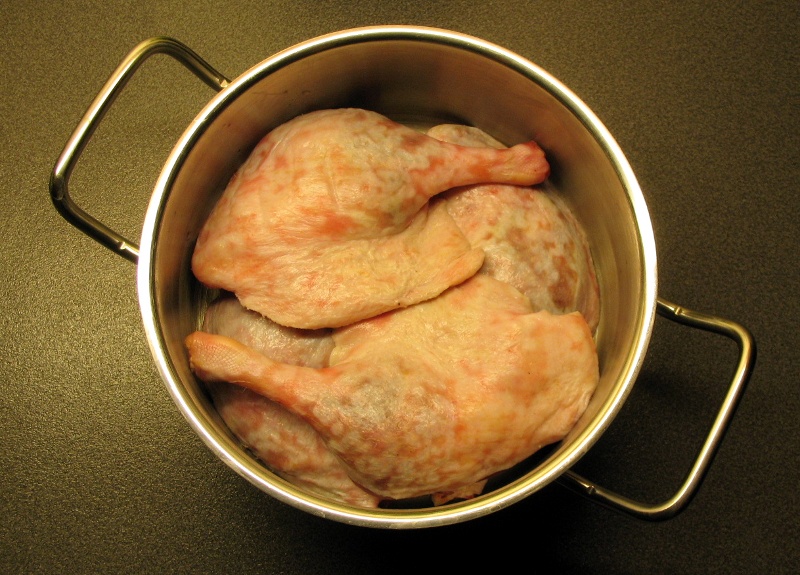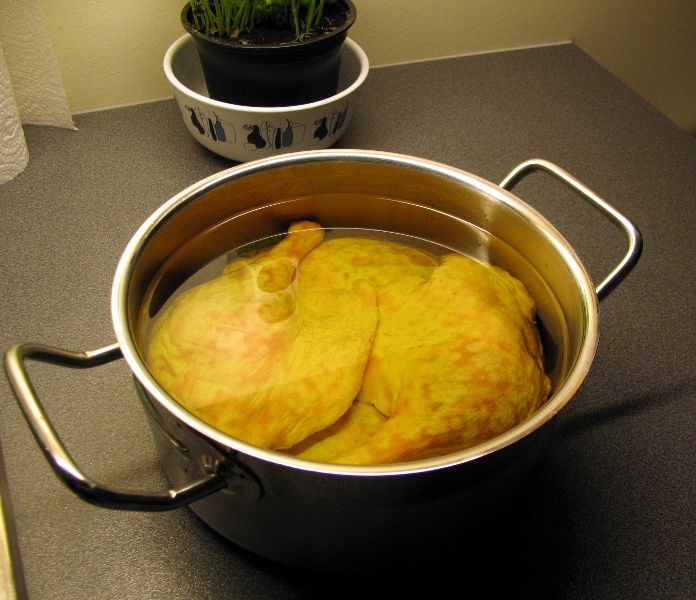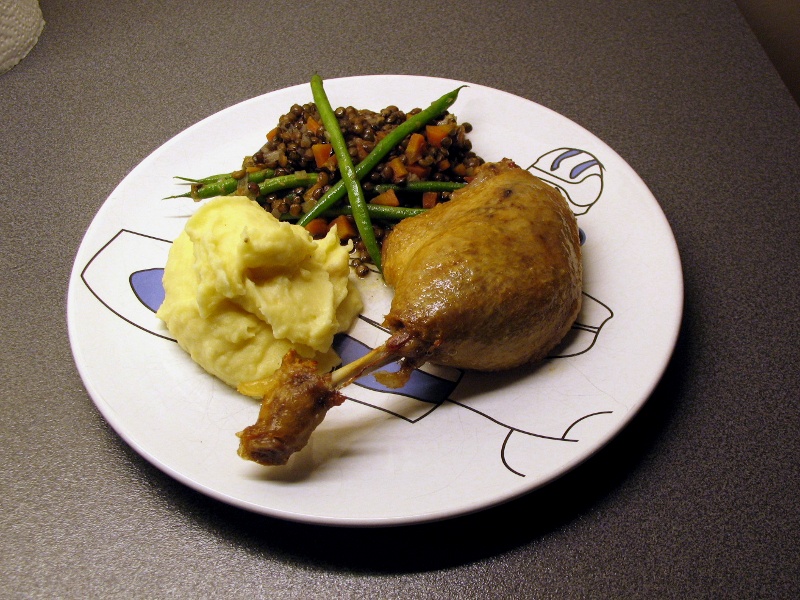I admit there's not a speck of either lactobacilli or saccharomyces cerevisiae on the ingredient list this time, but that doesn't mean it's no good... I've been busy in the kitchen (breadwise and otherwise) the last few weeks, but my blog's been sadly neglected. This weekend's dinner is something that really looks after itself once you've popped it into the oven, so I thought I could use the opportunity to snap a few photos.
Ever since I bought Ruhlman and Polcyn's book on charcuterie, I've wanted to try the confit method of cooking and preserving meat. Back in the day, after harvesting foie gras, French farmers of Gascony and the Dordogne had great quantities of duck meat and duck fat, but no easy way to conserve the meat, save for the confit technique. Today, with refrigeration, the main reason for using confit is the unique tenderness, texture and flavour of confited meat that make the technique worthwhile.
In brief, the meat is first dry cured with salt (add pepper, coarsely ground cloves and a clove of garlic if you like) for 24 hours. Rinse off all excess salt under cold, running water and place the meat in an ovenproof pot or casserole. Pour over rendered fat (or oil) so that all the meat is covered and place in a low oven for 8 - 12 hours, until the meat is beautifully tender and settled on the bottom of the baking vessel. Keep the meat submerged in the fat and cool to room temperature before covering the vessel with foil and refrigerating it. Both Ruhlman/Polcyn and Robuchon have great recipes for duck confit, that, if followed accurately, produce confits that can be kept for up to 6 months in the refrigerator. As the fat turns solid, and prevents air to reach the meat, the confit technique is a way of hermetically sealing meat.
I had problems obtaining duck fat, so I used a cheap olive oil as the poaching medium instead. The olive oil doesn't turn solid in the refrigerator, so this will not make a fully conserved duck confit. According to Ruhlman, it can still be kept for up to a month in the fridge, but mine won't last that long. Promise.
So... Rub your duck legs with generous amounts of coarse sea salt, a few ground cloves, pepper corns and a crushed clove of garlic. Place in the fridge for 24 hours, then rinse and place in a tight cooking vessel. The tighter you can place the meat in the vessel, the less fat/oil you need to use to cover the meat:

Fill it up all the way so that all meat is covered in rendered fat/oil:

Now, a good idea is to first warm the pot over medium-high heat until the oil is close to the simmering temperature of water. This will give the legs a good thermal kick in the beginning (otherwise you might have to extend the baking time in the oven by several hours). Then place in a low (approx 80 - 85 dC) oven, uncovered, until the meat is absolutely tender. One way to check whether it's finished, is to gently pierce the meat with a skewer. If the fat that runs out is a thin, liquid stream, it's done. My four legs were done in roughly 8 hours. Remove from oven and let the vessel come to room temperature before you cover it with foil and refrigerate it.
A simple but tasteful dish of confited duck legs can be made by cooking the legs at 220dC for 15 mins (the last few minutes with the broiler on to make a ridiculously crisp and delicious skin) and serving them with a ragu of lentils (I used green du Berry lentils), carrots, shallots, garlic, asparagus beans and a potato purée. Shredded duck confit is amazing in salads as well. Oh, and did I mention that this is great with bread too? A tasty duck rillette on freshly baked pain au levain... sacrebleu. Bon appétit!

- hansjoakim's Blog
- Log in or register to post comments
For heart-health reasons--although, I ocassionally challenge my Lipitor--I've avoided confits for two decades. Olive Oil! I never would have thought it. I've been curing hams and sausage, and smoking meats for three or four years, so this book seems a welcome addition to an already large food library.
What really sold me, however, was your absolutely delicious photographs, and mouth-watering description, especially "...a ridiculously crisp and delicious skin".
Thanks for posting.
David G
P.S. Where does one get asparagus beans?
Great to see one of your inspiring culinary posts Hans, they have been missed!
Arlo
Great and informative post, Hans. The dish did come together really nicely.
I found the confit duck to be quite salty, well, it could have been me not washing the salt off properly. I have only made it once and it put me off from making confit duck again. I still have half a kilo of duck fat sitting in the fridge. Though I found duck fat is still useful for Chinese chicken rice and roasted potatoes.
Sue
http://youcandoitathome.blogspot.com/
Thanks so much :)
David: Thanks! I'm sure you'll have lots of fun with the book. Ruhlman's a great food writer and Brian Polcyn brings years and years of experience to the table. Many consider it to be the best book around on charcuterie for the home cook. Look out for a follow-up book that Polcyn and Ruhlman are working on at the moment - not sure when it'll be out, but Ruhlman have mentioned it in some posts on his blog at ruhlman.com.
Substitute any kind of sweet green bean for the asparagus beans - especially any kind of haricots verts would do!
Thank you for posting this very informative method and Canard recipe. I have been experimenting with Sous Vide lately, on the stove top. There are some interesting similarities between the confit and sous vide. Both are essentially slow cooking at the most desirable eating temperature in an air free environment, for long periods of time. The sous vide is done in a vacuum sealed plastic bag in water held at the appropriate heat level. I have been cooking chicken breasts at 135F for 2-1/2 hours or longer. After cooking in the water bath, I crisp up the meat in a very hot iron pan for about 1 minute per side just to caramelize the exterior. The meat is perfectly tender through out and the skin is nicely flavored.
I'll have to try your method of crisping the skin in the oven. That would probably render more of the fat out from under the skin.
Eric
Indeed, in that respect it's similar to sous vide. I have read blogs on the net where people are describing their experiences with combining sous vide and confit (much less fat required).
I've wanted to try out sous vide myself for some time, but I would have to invest in some kitchen equipment first. That has put it on hold for me for now...
I guess you already have a vacuum sealer - do you use a ricer cooker or any special equipment for the water bath and temperature control? I've read that many upscale restaurants, not to mention those of the gourmet-food-as-high-art cooks, use sous vide extensively. It's really an ideal method to get the perfect core temperature of your meat - all you have to do afterwards is sear it a minute or two in a pan.
It's great to have you posting again. I missed you.
Duck confit is one of my favorite foods. I've not made it at home. I do make duck legs fairly often - usually roasted in the oven instead of browned in fat, then braised with fruit or a vegetable that gives off enough liquid to not require dilution ... well, some recipes use a bit of stock or wine.
I like the idea of using olive oil for confit, although by the end of cooking I'd guess that there is quite a bit of rendered duck fat in the oil.
David
I make duck, and pork, confit fairly often and love it but would never use olive oil OK, I recognise that you didn't have any but surely you could have bought some? We can in UK. Confit just isn't as luscious without using the appropriate fat.
Yes, I HAVE had it :-) Although i didn't cook it, it was at the table of a health freak friend.
Mary
Wonderful post Hans, coming at just the right time for me, as our local grocer has a sale on duck at the moment. Unfortunately it's not fresh, but the price is right. I've had duck confit several times in the past in restaurants and have always wanted to try making it for myself. The recipe looks like it would be perfectly suited to doing in my new counter top slow cooker that I've been using recently.
Thanks for posting the recipe and your gorgeous photos of the process.
Best Wishes,
Franko
Thanks for sharing, Hans. That looks absolutely delicious! I love the picture of the duck legs covered in olive oil. I've poached fish in olive oil and the result is wonderfully moist and completely non-greasy. I hadn't known the history of confit, but it makes complete sense as a way of preserving meats without refrigeration. Clever people, our ancestors!
Larry
Nice post.
I love duck confit. I have been meaning to make my own for years, but have been afraid to do so since if I succeed, I will gain 30 pounds, guaranteed.
Looks beautiful, but I'm going to try to keep the confit treat to a couple times a year.
Glenn
Beautiful!
I've made duck confit a couple of times, when I lived in Paris I brought with me two large containers of duck fat so the first time I made it I had enough to totally submerge the two legs I worked with. The second time, a few years down the line, I did not have enough, and completed the volume with normal oil - not olive oil, but if I remember correctly it was sunflower. I had read somewhere that a milder tasting oil would be better.
Both times I ended up using the crockpot to cook the meat, set on low - worked very well. One of our favorite dishes ni the world, I must make it again...
I ended up using the crockpot to cook the meat, set on low - worked very well
The crockpot! How obvious - and what a splendid idea! Thanks for that. I'm shopping this morning, some duck legs might just jump into my trolley :-)
Thanks!
Thanks for all your kind comments and replies, everyone!
I was also under the impression that to make real tasting duck confit, one had to use proper duck fat to get the right flavour. It makes sense: Use fat and meat from the same animal.
To be honest, I've only had duck confit once before, in a Parisian restaurant two years ago. And boy was it fabulous. I did read a bit about confits before doing it with olive oil instead of the real deal, and many sources suggested that it could be done with e.g. olive oil with great results. I loved my confited duck legs, but my memory is blunt, and I can't compare it to what I had those couple of years ago.
I really welcome a discussion about confit, and hope everyone with experience can weigh in with their thoughts and ideas! Belive me, I trawled the city for duck fat, but the only option I was given was by a butcher who could order it for me at a high cost and with a long delivery time. I was both surprised and disappointed, because duck fat has so many other applications...If I had had duck fat readily available I would definitely have used it instead of olive oil. Then I would've known what it "should" taste like, and be in a better position to compare with olive oil as poaching medium instead.
I promise to try harder next time :)
Dr. Nathan Myhrvold, one of the authors behind the upcoming monster "Modernist Cuisine", has said in a NY Times article that the poaching medium isn't as important as most people think. The choice of fat imparts flavour to the skin, but not the meat itself. Far more important for the flavour, is the ageing or ripening of the meat. Back in the days when the confit was kept for months (meat submerged in hardened duck fat), the meat itself acquired a more distinct flavour as weeks went by. I believe it is McGee, in his book on cooking, who said that a certain "rancidity" was not unheard of, and actually valued.
Dr. Myhrvold expanded a bit on the NYT article in an eGullet forum post:
It's a controversial statement, but I really like Dr. Myhrvold's questioning and will to experiment.
As far as I can tell, important factors with the confit style of cooking is that:
Even though I poached my duck legs in a cheap olive oil, I could only make out a very, very subtle olive oil flavour to certain parts of the skin. There's a lot of duck fat on the legs themselves to provide the "right" flavour.
I've spent the last hour scanning it, and reading Chapter 1: The reasons for this food, for this book. I'm hooked. Just like TFL and Hamelman's Bread motivated me to "kick my bread- baking up a notch", you're original post, introducing this book, inspired me similarly.
I already cure fresh hams, brine turkeys, make fresh pork sausages and smoke meats, so I'm starting with at least a base, but only a base. Move over sourdoughs, I won't neglect baking, but I've found another notch to climb.
Thank you, Hans
David G
I'm delighted to hear your enthusiasm about the book, David!
I know I would be very interested in reading any future charcuterie blog posts you would want to write :)
My enthusiasm, if possible, has increased as I've worked with the book. I've seldom encountered "How-to" books written with the clarity, and completeness Charcuterie offers. The co-authorship--one journalist, one master chef--works wonderfully.
I've been focusing on hot smoking both cured and uncured meats, and pates and terrines. To date I've made:
Sweet Italian sausage, Breakfast Sausage with Fresh Ginger and Sage, Corned Beef, Pate de Campagne, Shrimp and Salmon Terrine with Spinach and Mushrooms, Pate en Terrine with Pork Tenderloin Inlay, Pastrami, Canadian Bacon, Spicy Smoke-Roasted Pork Loin, and Smoked Turkey Legs using Charcuterie's poultry brine (tarragon). I served the Pate Campagne and Shrimp/Salmon Terrine at our annual open house ( http://www.thefreshloaf.com/node/23011/fifth-annual-open-house ). The Terrine with Tenderloin Inlay will be served at a dinner party tonight.
During a recent smoke--the pastrami, Canadian bacon, turkey legs, and spicy pork loin roast--I experimented with my Bradley smoker to determine how low a smoke temperature I could realize. Unfortunately, it steadied at 120°F: too hot for cold smoking (< 90°F required), but I'm not discouraged. Next smoke I'm going to place a bag of ice on the lowest shelf and see how low that will cool the smoke before reaching whatever I'm smoking. If that doesn't work I've other ideas to test.
We are leaving Saturday for Amsterdam and a Rhine river cruise. When we return I'm going to spend much of the rest of the summer working with different sausage recipes, cold-smoking recipes, and ultimately dry-cured and fermented meat recipes. A friend has given me ten lbs (4.5 kg) of ground venison; early on I'm going to make Charcuterie's Chef Milo's Country Venison Sausage (hot-smoked), and Venison Terrine with Dried Cherries.
So far, I've followed the recipes and techniques faithfully, but as I gain confidence I'll certainly add my own spin. Thanks again for drawing my attention to a cooking niche I've only explored superficially, until now.
David G
Ruhlman's website has a great discussion of duck confit.
http://ruhlman.com/2010/09/how-to-make-duck-confit-fall-is-here-time-to-preserve-duck.htm
I'm planning to find a six-legged duck tomorrow.
Glenn